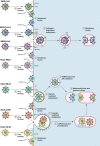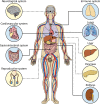Severe Acute Respiratory Syndrome Coronavirus 2 (SARS-CoV-2): a Systemic Infection
- PMID: 33441314
- PMCID: PMC7849242
- DOI: 10.1128/CMR.00133-20
Severe Acute Respiratory Syndrome Coronavirus 2 (SARS-CoV-2): a Systemic Infection
Abstract
To date, seven identified coronaviruses (CoVs) have been found to infect humans; of these, three highly pathogenic variants have emerged in the 21st century. The newest member of this group, severe acute respiratory syndrome coronavirus 2 (SARS-CoV-2), was first detected at the end of 2019 in Hubei province, China. Since then, this novel coronavirus has spread worldwide, causing a pandemic; the respiratory disease caused by the virus is called coronavirus disease 2019 (COVID-19). The clinical presentation ranges from asymptomatic to mild respiratory tract infections and influenza-like illness to severe disease with accompanying lung injury, multiorgan failure, and death. Although the lungs are believed to be the site at which SARS-CoV-2 replicates, infected patients often report other symptoms, suggesting the involvement of the gastrointestinal tract, heart, cardiovascular system, kidneys, and other organs; therefore, the following question arises: is COVID-19 a respiratory or systemic disease? This review aims to summarize existing data on the replication of SARS-CoV-2 in different tissues in both patients and ex vivo models.
Keywords: COVID-19; SARS-CoV-2; coronavirus; disease; infection; organoids; organs; systemic.
Copyright © 2021 American Society for Microbiology.
Figures






References
-
- Woo PC, Lau SK, Chu CM, Chan KH, Tsoi HW, Huang Y, Wong BH, Poon RW, Cai JJ, Luk WK, Poon LL, Wong SS, Guan Y, Peiris JS, Yuen KY. 2005. Characterization and complete genome sequence of a novel coronavirus, coronavirus HKU1, from patients with pneumonia. J Virol 79:884–895. doi:10.1128/JVI.79.2.884-895.2005. - DOI - PMC - PubMed
-
- Ksiazek TG, Erdman D, Goldsmith CS, Zaki SR, Peret T, Emery S, Tong S, Urbani C, Comer JA, Lim W, Rollin PE, Dowell SF, Ling AE, Humphrey CD, Shieh WJ, Guarner J, Paddock CD, Rota P, Fields B, DeRisi J, Yang JY, Cox N, Hughes JM, LeDuc JW, Bellini WJ, Anderson LJ, Group SW, SARS Working Group . 2003. A novel coronavirus associated with severe acute respiratory syndrome. N Engl J Med 348:1953–1966. doi:10.1056/NEJMoa030781. - DOI - PubMed
Publication types
MeSH terms
LinkOut - more resources
Full Text Sources
Other Literature Sources
Medical
Miscellaneous

